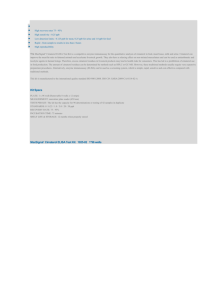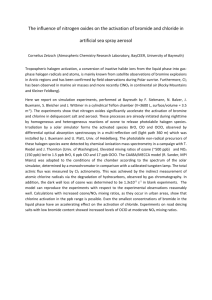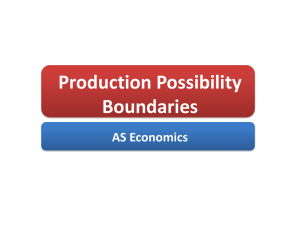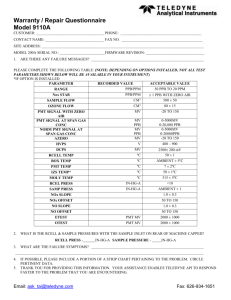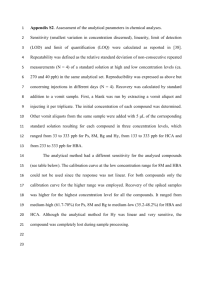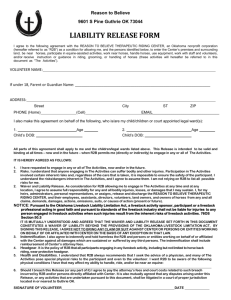4816
advertisement
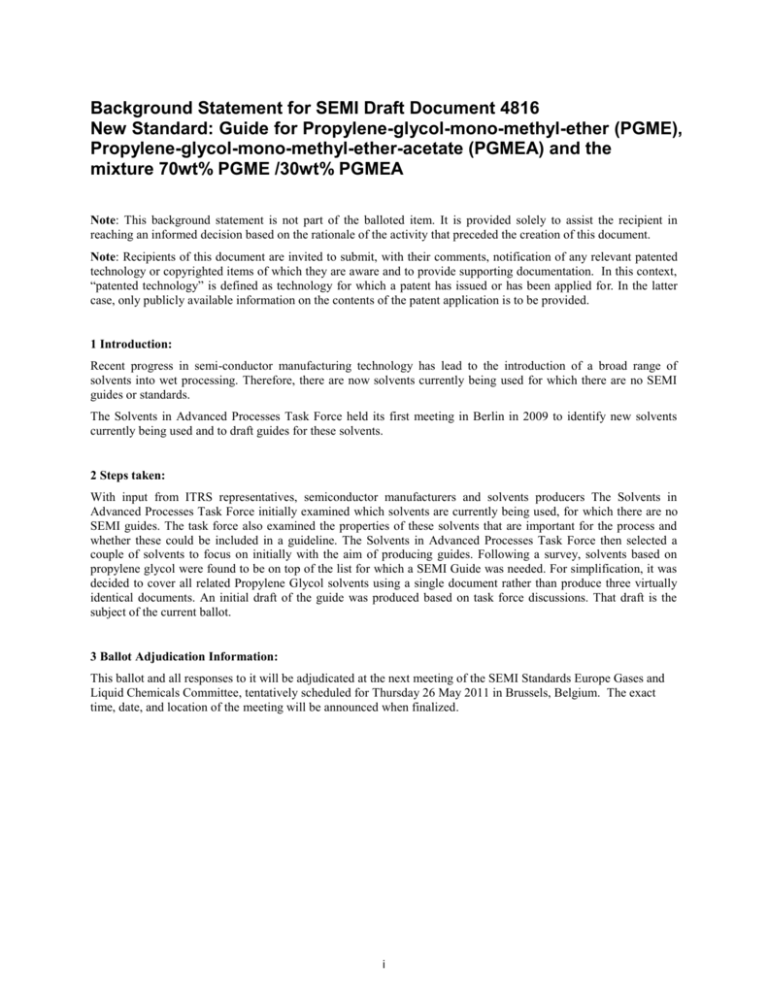
Background Statement for SEMI Draft Document 4816 New Standard: Guide for Propylene-glycol-mono-methyl-ether (PGME), Propylene-glycol-mono-methyl-ether-acetate (PGMEA) and the mixture 70wt% PGME /30wt% PGMEA Note: This background statement is not part of the balloted item. It is provided solely to assist the recipient in reaching an informed decision based on the rationale of the activity that preceded the creation of this document. Note: Recipients of this document are invited to submit, with their comments, notification of any relevant patented technology or copyrighted items of which they are aware and to provide supporting documentation. In this context, “patented technology” is defined as technology for which a patent has issued or has been applied for. In the latter case, only publicly available information on the contents of the patent application is to be provided. 1 Introduction: Recent progress in semi-conductor manufacturing technology has lead to the introduction of a broad range of solvents into wet processing. Therefore, there are now solvents currently being used for which there are no SEMI guides or standards. The Solvents in Advanced Processes Task Force held its first meeting in Berlin in 2009 to identify new solvents currently being used and to draft guides for these solvents. 2 Steps taken: With input from ITRS representatives, semiconductor manufacturers and solvents producers The Solvents in Advanced Processes Task Force initially examined which solvents are currently being used, for which there are no SEMI guides. The task force also examined the properties of these solvents that are important for the process and whether these could be included in a guideline. The Solvents in Advanced Processes Task Force then selected a couple of solvents to focus on initially with the aim of producing guides. Following a survey, solvents based on propylene glycol were found to be on top of the list for which a SEMI Guide was needed. For simplification, it was decided to cover all related Propylene Glycol solvents using a single document rather than produce three virtually identical documents. An initial draft of the guide was produced based on task force discussions. That draft is the subject of the current ballot. 3 Ballot Adjudication Information: This ballot and all responses to it will be adjudicated at the next meeting of the SEMI Standards Europe Gases and Liquid Chemicals Committee, tentatively scheduled for Thursday 26 May 2011 in Brussels, Belgium. The exact time, date, and location of the meeting will be announced when finalized. i Semiconductor Equipment and Materials International 3081 Zanker Road San Jose, CA 95134-2127 Phone:408.943.6900 Fax: 408.943.7943 SEMI Draft Document 4816 New Standard: Guide for Propylene-glycol-mono-methyl-ether (PGME), Propylene-glycol-mono-methyl-ether-acetate (PGMEA) and the mixture 70wt% PGME / 30wt% PGMEA 1 Purpose 1.1 The purpose of this document is to provide a guide for Propylene-glycol-mono-methyl-ether (PGME), Propylene-glycol-mono-methyl-ether-acetate (PGMEA) and the mixture 70wt% PGME / 30wt% PGMEA for which a need has been identified. 2 Scope 2.1 The scope of this document covers Propylene-glycol-mono-methyl-ether (PGME), Propylene-glycol-monomethyl-ether-acetate (PGMEA) and the mixture 70wt% PGME / 30wt% PGMEA which are used as solvents in the semiconductor industry for advanced resist technology. 3 Limitations NOTICE: This standard does not purport to address safety issues, if any, associated with its use. It is the responsibility of the users of this standard to establish appropriate safety and health practices and determine the applicability of regulatory or other limitations prior to use. 4 Referenced Standards 4.1 SEMI Standards SEMI C1 Guide for the Analysis of Liquid Chemicals ASTM D51271 – Standard Guide for Ultra Pure Water Used in the Electronics and Semiconductor Industry NOTE 1: As listed or revised, all documents cited shall be the latest publications of adopted standards. 5 Terminology 5.1 Acronyms 5.1.1 PGME : propylene glycol mono methyl ether (IUPAC : 1-methoxy-propan-2-ol) 5.1.2 PGMEA : propylene glycol mono methyl ether acetate (IUPAC : 1-methoxypropan-2-yl acetate) 6 Properties Table 1 Properties of PGME (for information only) Molecular formula CH3-O-CH2-CH(CH3)-OH Molecular weight 90.1 g/mol CAS number 107-98-2 1589-47-5 (b isomer < 0.5 %) Density 0.92 g/cm3 Boiling point 120 °C (1013 hPa) Vapor pressure 11.5 hPa @ 20 °C Melting point -97°C Solubility in water Miscible (200 g/l @ 20 °C) American Society for Testing and Materials, 100 Barr Harbor Drive, West Conshohocken, Pennsylvania 19428-2959, USA. Telephone: 610.832.9585, Fax: 610.832.9555 Website: www.astm.org This is a draft document of the SEMI International Standards program. No material on this page is to be construed as an official or adopted standard. Permission is granted to reproduce and/or distribute this document, in whole or in part, only within the scope of SEMI International Standards committee (document development) activity. All other reproduction and/or distribution without the prior written consent of SEMI is prohibited. Page 1 Doc. 4816 SEMI LETTER BALLOT DRAFT Document Number: 4816 Date: 2011/02/04 Semiconductor Equipment and Materials International 3081 Zanker Road San Jose, CA 95134-2127 Phone:408.943.6900 Fax: 408.943.7943 DRAFT Document Number: 4816 Date: 2011/02/04 Molecular formula CH3-O-CH2-CH(CH3)-O-CO-CH3 Molecular weight 132.2 g/mol CAS number 108-65-6 Density 0.97 g/cm3 Boiling point 146 °C (1013 hPa) Vapor pressure 4.9 hPa @ 20 °C Melting point -66 °C Solubility in water Miscible (200 g/l @ 20 °C) LETTER BALLOT Table 2 Properties of PGMEA (for information only) 7 Suggested Values 7.1 The suggested values for Propylene-glycol-mono-methyl-ether (PGME), Propylene-glycol-mono-methyl-etheracetate (PGMEA) and the mixture 70wt% PGME / 30wt% PGMEA for Tier A are listed in Table 3. 8 Grade 1 Procedures 8.1 This section does not apply to this chemical. 9 Grade 2 Procedures 9.1 This section does not apply to this chemical. 10 Grade 3 Procedures 10.1 This section does not apply to this chemical. 11 Grade 4 Procedures 11.1 This section does not apply to this chemical. 12 Tier A Procedures Standardized test methods are being developed for all parameters at the purity level indicated. Until standardized test methods are published, test methodology shall be determined by user and producer. The Global Liquid Chemicals Committee considers a method to be valid only if method validation according to SEMI C1 has been demonstrated. 12.1 Assay – Analyze the sample by gas chromatography (see SEMI C1, Guidelines for Assay by Wide Bore Column Gas Chromatography). The parameters cited have given satisfactory results. Column: 50 meters * 45 microns I.D. fused silica capillary, coated with 100% dimethyl-polysiloxane which has been surface bounded. Column Temperature: 80 °C isothermal for 3 minutes then programmed with intervals of 20 °C/min to 260 °C for 5 minutes. Injector Temperature: 75 °C Detector Temperature: 280 °C Sample Size: 1.0 µL split ratio 1/50 Carrier Gas: Helium Detector: Flame Ionization Detector (Hydrogen gas) This is a draft document of the SEMI International Standards program. No material on this page is to be construed as an official or adopted standard. Permission is granted to reproduce and/or distribute this document, in whole or in part, only within the scope of SEMI International Standards committee (document development) activity. All other reproduction and/or distribution without the prior written consent of SEMI is prohibited. Page 2 Doc. 4816 SEMI Semiconductor Equipment and Materials International 3081 Zanker Road San Jose, CA 95134-2127 Phone:408.943.6900 Fax: 408.943.7943 12.2 Color – Dilute 2.0 mL of platinum-cobalt solution (APHA N° 500, see SEMI C1) to 100 mL with water. Compare this standard (APHA N° 10) with 100 mL of sample in Nessler tubes. View vertically over a white background. The sample must be no darker than the standard. 12.3 Water – Add 25 mL of methanol to a dry titration flask and add Karl Fisher (KF) reagent to a visually or electrometrically determined endpoint that persists for 30 seconds. Add 20 grams of sample, taking care to protect the sample and contents of the flask from moisture. Stir vigorously and titrate with Karl Fisher reagent to the same endpoint. volume of KF reagent (mL) x KF factor (gH2O/mL) x 100 % Water (H2O) = Weight of sample (g) 12.4 Acidity – To 50 grams of sample in a 250 mL conical flask, add 25 mL of methanol and 0.5 mL of phenolphthalein indicator solution. Titrate with 0.1 N methanolic sodium hydroxide solution until a slight pink color persists for at least 15 seconds. Volume of NaOH (mL) x Normality of NaOH (mole/L) x 60,000 ppm Acidity (CH3COOH) = Weight of sample (g) 12.5 Trace Metal Analysis – The following method has given satisfactory results in determining trace metal impurities at the specified values for each of the following trace metals : aluminium (Al), antimony (Sb), arsenic (As), barium (Ba), boron (B), cadmium (Cd), calcium (Ca), chromium (Cr), copper (Cu), iron (Fe), lead (Pb), lithium (Li), magnesium (Mn), manganese (Mn), nickel (Ni), potassium (K), sodium (Na), tin (Sn), titanium (Ti) and zinc (Zn). 12.5.1 Special Reagents 12.5.1.1 Nitric Acid Ultra Pure – Use concentrated nitric acid with metal ion content less than 1 ppb for each element of interest (see § 12.4). 12.5.1.2 Hydrofluoric Acid Ultra Pure – Use concentrated hydrofluoric acid with metal ion content less than 1 ppb for each element of interest (see § 12.4). 12.5.1.3 Water – The water used for all of the dilutions, calibrations, and standards shall be the appropriate grade of 18.2 Mohm-cm water that meets the criteria for Type E1.2 in ASTM D 5127 for the elements of interest. 12.5.2 Sample Preparation. 12.5.2.1 In a clean environment, place 20 grams of sample in a PTFE beaker. Slowly evaporate on a hot plate (180 – 190 °C) avoiding loss of sample by effervescence or spattering. Continue the evaporation to almost complete dryness. Cool. Add 2 mL of a 2:1 HNO3/HF mixture. Carefully warm at 80 °C for 5 minutes to dissolve any residue. Cool. Dilute with water (12.4.1.3) to a final weight of 20 grams. Run each sample in duplicate. Run a reagent blank. 12.5.3 Analysis 12.4.3.1 Using the prepared samples and blank, analyze the specified elements by ICP-OES and/or ICP-MS and/or GF-AAS using the appropriate standard solutions. Apply if necessary, a reagent blank correction to the final determined value of the samples. 13 Tier B Procedures 13.1 This section does not apply to this chemical. 14 Tier C Procedures 14.1 This section does not apply to this chemical. This is a draft document of the SEMI International Standards program. No material on this page is to be construed as an official or adopted standard. Permission is granted to reproduce and/or distribute this document, in whole or in part, only within the scope of SEMI International Standards committee (document development) activity. All other reproduction and/or distribution without the prior written consent of SEMI is prohibited. Page 3 Doc. 4816 SEMI LETTER BALLOT DRAFT Document Number: 4816 Date: 2011/02/04 Semiconductor Equipment and Materials International 3081 Zanker Road San Jose, CA 95134-2127 Phone:408.943.6900 Fax: 408.943.7943 15 Tier D Procedures 15.1 This section does not apply to this chemical. Table 3 Impurity Limits and Other Suggested Values for Propylene-glycol-mono-methyl-ether (PGME), Propylene-glycol-mono-methyl-ether-acetate (PGMEA) and the mixture 70wt% PGME / 30wt% PGMEA Previous SEMI Reference # Assay (PGME) PGME PGMEA PGME/PGMEA (70%/30% w/w) Tier A Tier A Tier A (Guide) (Guide) (Guide) ≥ 99.5% -- 70.0 +/- 1.0% Assay (PGMEA) -- ≥ 99.5% 30.0 +/- 1.0% 2-methoxy-1-propanol (b isomer) ≤ 0.3% -- -- 2-methoxy-1-propylacetate (b isomer) -- ≤ 0.3% -- -- -- ≤ 0.5% Sum of 2-methoxy-1propanol and 2-methoxy-1propylacetate (b isomers) Color (APHA) < 10 < 10 < 10 Water 0.1 % max. Free Acid (as CH3COOH) 300 ppm max. Aluminium (Al) 0.1 % max. 300 ppm max. 10 ppb max. Antimony (Sb) 10 ppb max. 10 ppb max. 0.1 % max. 300 ppm max. 10 ppb max. 10 ppb max. 10 ppb max. Arsenic (As) 10 ppb max. 10 ppb max. 10 ppb max. Barium (Ba) 10 ppb max. 10 ppb max. 10 ppb max. Boron (B) 10 ppb max. 10 ppb max. 10 ppb max. Cadmium (Cd) 10 ppb max. 10 ppb max. 10 ppb max. Calcium (Ca) 10 ppb max. 10 ppb max. 10 ppb max. Chromium (Cr) 10 ppb max. 10 ppb max. 10 ppb max. Copper (Cu) 10 ppb max. 10 ppb max. 10 ppb max. Iron (Fe) 10 ppb max. 10 ppb max. 10 ppb max. Lead (Pb) 10 ppb max. 10 ppb max. 10 ppb max. Lithium (Li) 10 ppb max. 10 ppb max. 10 ppb max. Magnesium (Mg) 10 ppb max. 10 ppb max. 10 ppb max. Manganese (Mn) 10 ppb max. 10 ppb max. 10 ppb max. Nickel (Ni) 10 ppb max. 10 ppb max. 10 ppb max. Potassium (K) 10 ppb max. 10 ppb max. 10 ppb max. Sodium (Na) 10 ppb max. 10 ppb max. 10 ppb max. Tin (Sn) 10 ppb max. 10 ppb max. 10 ppb max. Titanium (Ti) Vanadium (V) 10 ppb max. -- 10 ppb max. -- 10 ppb max. -- Zinc (Zn) 10 ppb max. 10 ppb max. 10 ppb max. This is a draft document of the SEMI International Standards program. No material on this page is to be construed as an official or adopted standard. Permission is granted to reproduce and/or distribute this document, in whole or in part, only within the scope of SEMI International Standards committee (document development) activity. All other reproduction and/or distribution without the prior written consent of SEMI is prohibited. Page 4 Doc. 4816 SEMI LETTER BALLOT DRAFT Document Number: 4816 Date: 2011/02/04 Semiconductor Equipment and Materials International 3081 Zanker Road San Jose, CA 95134-2127 Phone:408.943.6900 Fax: 408.943.7943 NOTICE: SEMI makes no warranties or representations as to the suitability of the standard(s) set forth herein for any particular application. The determination of the suitability of the standard(s) is solely the responsibility of the user. Users are cautioned to refer to manufacturer’s instructions, product labels, product data sheets, and other relevant literature respecting any materials or equipment mentioned herein. These standards are subject to change without notice. By publication of this standard, Semiconductor Equipment and Materials International (SEMI) takes no position respecting the validity of any patent rights or copyrights asserted in connection with any item mentioned in this standard. Users of this standard are expressly advised that determination of any such patent rights or copyrights, and the risk of infringement of such rights are entirely their own responsibility. This is a draft document of the SEMI International Standards program. No material on this page is to be construed as an official or adopted standard. Permission is granted to reproduce and/or distribute this document, in whole or in part, only within the scope of SEMI International Standards committee (document development) activity. All other reproduction and/or distribution without the prior written consent of SEMI is prohibited. Page 5 Doc. 4816 SEMI LETTER BALLOT DRAFT Document Number: 4816 Date: 2011/02/04
